The AMD Ryzen Threadripper 1950X and 1920X Review: CPUs on Steroids
by Ian Cutress on August 10, 2017 9:00 AM ESTCreator Mode and Game Mode
*This page was updated on 8/17. A subsequent article with new information has been posted.
Due to the difference in memory latency between the two pairs of memory channels, AMD is implementing a ‘mode’ strategy for users to select depending on their workflow. The two modes are called Creator Mode (default), and Game Mode, and control two switches in order to adjust the performance of the system.
The two switches are:
- Legacy Compatibility Mode, on or off (off by default)
- Memory Mode: UMA vs NUMA (UMA by default)
The first switch disables the cores in one fo the silicon dies, but retains access to the DRAM channels and PCIe lanes. When the LCM switch is off, each core can handle two threads and the 16-core chip now has a total of 32 threads. When enabled, the system cuts half the cores, leaving 8 cores and 16 threads. This switch is primarily for compatibility purposes, as certain games (like DiRT) cannot work with more than 20 threads in a system. By reducing the total number of threads, these programs will be able to run. Turning the cores in one die off also alleviates some potential pressure in the core microarchitecture for cross communication.
The second switch, Memory Mode, puts the system into a unified memory architecture (UMA) or a non-unified memory architecture (NUMA) mode. Under the default setting, unified, the memory and CPU cores are seen as one massive block to the system, with maximum bandwidth and an average latency between the two. This makes it simple for code to understand, although the actual latency for a single instruction will be a good +20% faster or slower than the average, depending on which memory bank it is coming from.
NUMA still gives the system the full memory, but splits the memory and cores into into two NUMA banks depending on which pair of memory channels is nearest the core that needs the memory. The system will keep the data for a core as near to it as possible, giving the lowest latency. For a single core, that means it will fill up the memory nearest to it first at half the total bandwidth but a low latency, then the other half of the memory at the same half bandwidth at a higher latency. This mode is designed for latency sensitive workloads that rely on the lower latency removing a bottleneck in the workflow. For some code this matters, as well as some games – low latency can affect averages or 99th percentiles for game benchmarks.
The confusing thing about this switch is that AMD is calling it ‘Memory Access Mode’ in their documents, and labeling the two options as Local and Distributed. This is easier to understand than the SMT switch, in that the Local setting focuses on the latency local to the core (NUMA), and the Distributed setting focuses on the bandwidth to the core (UMA), with Distributed being default.
- When Memory Access Mode is Local, NUMA is enabled (Latency)
- When Memory Access Mode is Distributed, UMA is enabled (Bandwidth, default)
So with that in mind, there are four ways to arrange these two switches. AMD has given two of these configurations specific names to help users depending on how they use their system: Creator Mode is designed to give as many threads as possible and as much memory bandwidth as possible. Game Mode is designed to optimize for latency and compatibility, to drive game frame rates.
| AMD Threadripper Options | |||||
| Words That Make Sense | Marketing Spiel | ||||
| Ryzen Master Profile |
Two Dies or One Die |
Memory Mode |
Legacy Compatibility Mode |
Memory Access Mode |
|
| Creator Mode | Two | UMA | Off | Distributed | |
| - | Two | NUMA | Off | Local | |
| - | One | UMA | On | Distributed | |
| Game Mode | One | NUMA | On | Local | |
There are two ways to select these modes, although this is also a confusing element to this situation.
The way I would normally adjust these settings is through the BIOS, however the BIOS settings do not explicitly state ‘Creator Mode’ and ‘Game Mode’. They should give immediate access for the Memory Mode, where ASUS has used the Memory Access naming for Local and Distributed, not NUMA and UMA. For the Legacy Compatibility Mode, users will have to dive several screens down into the Zen options and manually switch off eight of the cores, if the setting is going to end up being visible to the user. This makes Ryzen Master the easiest way to implement Game Mode.
While we were testing Threadripper, AMD updated Ryzen Master several times to account for the latest updates, so chances are that by the time you are reading this, things might have changed again. But the crux is that Creator Mode and Game Mode are not separate settings here either. Instead, AMD is labelling these as ‘profiles’. Users can select the Creator Mode profile or the Game Mode profile, and within those profiles, the two switches mentioned above (labelled as Legacy Compatibility Mode and Memory Access Mode) will be switched as required.
Cache Performance
As an academic exercise, Creator Mode and Game Mode make sense depending on the workflow. If you don’t need the threads and want the latency bump, Game Mode is for you. The perhaps odd thing about this is that Threadripper is aimed at highly threaded workloads more than gaming, and so losing half the threads in Game Mode might actually be a detriment to a workstation implementation. That being said, users can leave SMT on and still change the memory access mode on its own, although AMD is really focusing more on the Creator and Game mode specifically.
For this review, we tested both Creator (default) and Game modes on the 16-core Threadripper 1950X. As an academic exercise we looked into memory latency in both modes, as well as at higher DRAM frequencies. These latency numbers take the results for the core selected (we chose core 2 in each case) and then stride through to hit L1, L2, L3 and main memory. For UMA systems like in Creator Mode, main memory will be an average between the near and far memory results. We’ve also added in here a Ryzen 5 1600X as an example of a single Zeppelin die, and a 6950X Broadwell for comparison. All CPUs were run at DDR4-2400, which is the maximum supported at two DIMMs per channel.
For the 1950X in the two modes, the results are essentially equal until we hit 8MB, which is the L3 cache limit per CCX. After this, the core bounces out to main memory, where the Game mode sits around 79ns while the Creator mode is at 108 ns. By comparison the Ryzen 5 1600X seems to have a lower latency at 8MB (20ns vs 41 ns), and then sits between the Creator and Game modes at 87 ns. It would appear that the bigger downside of Creator mode in this way is the fact that main memory accesses are much slower than normal Ryzen or in Game mode.
If we crank up the DRAM frequency to DDR4-3200 for the Threadripper 1950X, the numbers change a fair bit:
Up until the 8MB boundary where L3 hits main memory, everything is pretty much equal. At 8MB however, the latency at DDR4-2400 is 41ns compared to 18ns at DDR4-3200. Then out into full main memory sees a pattern: Creator mode at DDR4-3200 is close to Game Mode at DDR4-2400 (87ns vs 79ns), but taking Game mode to DDR4-3200 drops the latency down to 65ns.
Another element we tested while in Game Mode was the latency for near memory and far memory as seen from a single core. Remember this slide from AMD’s deck?
In our testing, we achieved the following:
- At DDR4-2400, 79ns near memory and 136ns far memory (108ns average)
- At DDR4-3200, 65ns near memory and 108ns far memory (87ns average)
Those average numbers are what we get for Creator mode by default, indicating that the UMA mode in Creator mode will just use memory at random between the two.


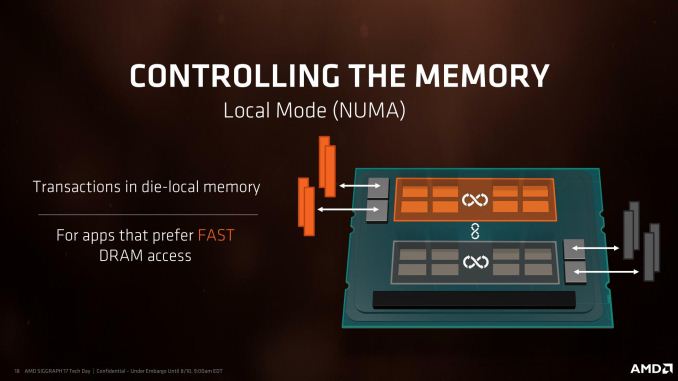
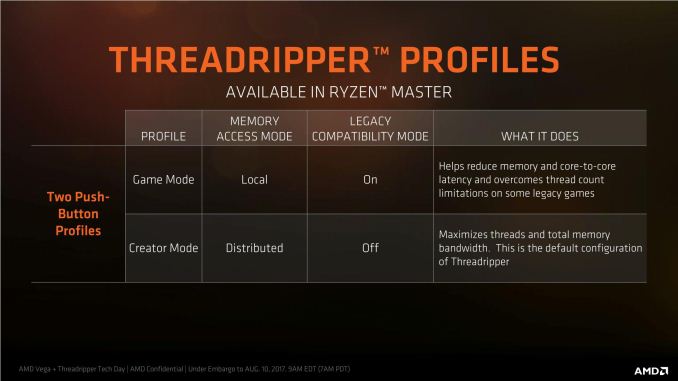
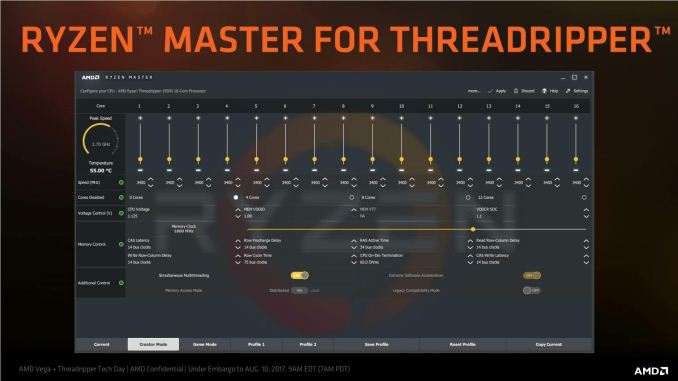
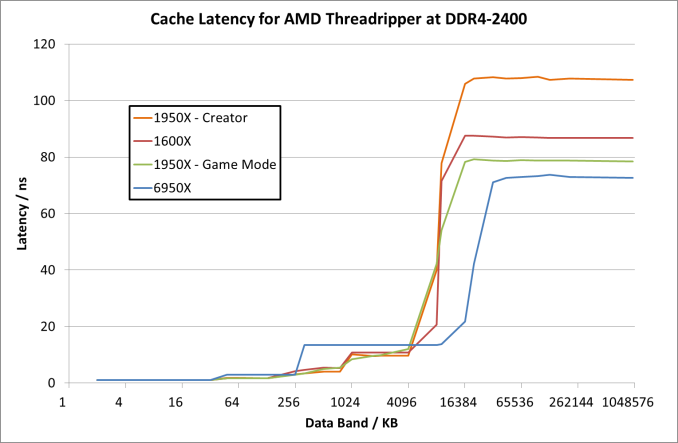
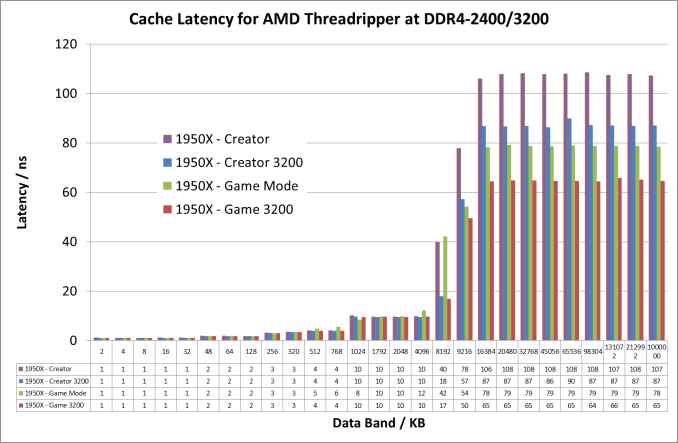
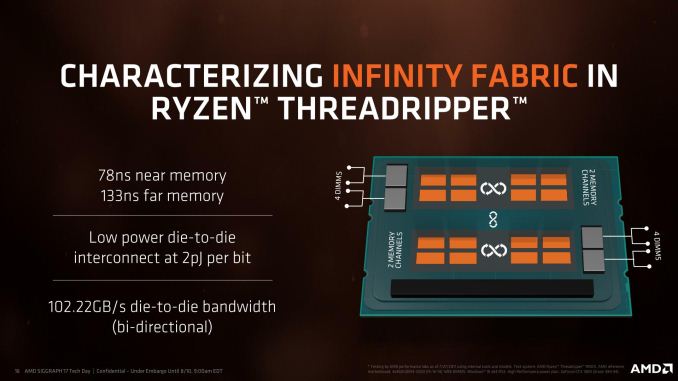




















347 Comments
View All Comments
Kjella - Thursday, August 10, 2017 - link
In the not so distant past - like last year - you'd have to pay Intel some seriously overpriced HEDT money for 6+ cores. Ryzen gave us 8 cores and most games can't even use that. ThreadRipper is a kick-ass processor in the workstation market. Why anyone would consider it for gaming I have no idea. It's giving you tons of PCIe lanes just as AMD is downplaying CF with Vega, nVidia has offically dropped 3-way/4-way support, even 2-way CF/SLI has been a hit-and-miss experience. I went from a dual card setup to a single 1080 Ti, don't think I'll ever do multi-GPU again.tamalero - Thursday, August 10, 2017 - link
Probably their target is for those systems that have tons of cards with SATA RAID ports or PCI-E accelerators like AMD's or Nvidia's?mapesdhs - Thursday, August 10, 2017 - link
And then there's GPU acceleration for rendering (eg. CUDA) where the SLI/CF modes are not needed at all. Here's my old X79 CUDA box with quad 900MHz GTX 580 3GB:http://www.sgidepot.co.uk/misc/3930K_quad580_13.jp...
I recall someone who does quantum chemistry saying they make significant use of multiple GPUs, and check out the OctaneBench CUDA test, the top spot has eleven 1080 Tis. :D (PCIe splitter boxes)
GreenMeters - Thursday, August 10, 2017 - link
There is no such thing as SHED. Ryzen is a traditional desktop part. That it raises the bar in that segment compared to Intel's offering is a good thing--a significant performance and feature boost that we haven't seen in years. Threadripper is a HEDT part. That it raises the bar in that segment compared to Intel's offering is a good thing--a significant performance and feature boost that we haven't seen in years.Ian Cutress - Thursday, August 10, 2017 - link
Ryzen 7 was set as a HEDT directly against Intel's HEDT competition. This is a new socket and a new set over and above that, and not to mention that Intel will be offering its HCC die on a consumer platform for the first time, increasing the consumer core count by 8 in one generation which has never happened before. If what used to be HEDT is still HEDT, then this is a step above.Plus, AMD call it something like UHED internally. I prefer SHED.
FreckledTrout - Thursday, August 10, 2017 - link
I think AMD has the better division of what is and isn't HEDT. Going forward Intel really should follow suite and make it 8+ cores to get into the HEDT lineup as what they have done this go around is just confusing and a bit goofy.ajoy39 - Thursday, August 10, 2017 - link
Small nitpick but"AMD could easily make those two ‘dead’ silicon packages into ‘real’ silicon packages, and offer 32 cores"
That's exactly what the, already announced, EPYC parts are doing is it not?
Great review otherwise, these parts are intriguing but I don't personally have a workload that would suit them. Excited to see what sort of innovation this brings about though, about time Intel had some competition at this end of the market.
Dr. Swag - Thursday, August 10, 2017 - link
I assume they're referring to putting 32 cores on TR4mapesdhs - Thursday, August 10, 2017 - link
Presumably a relevant difference being that such a 32c TR would have the use of all of its I/O connections, instead of some of them used to connect to other EPYC units. OTOH, with a 32c TR, how the heck could mbd vendors cram enough RAM slots on a board to feed the 8 channels? Either that or stick with 8 slots and just fiddle around somehow so that the channel connections match the core count in a suitable manner, eg. one per channel for 32c, 2 per channel for 16c, etc.Who knows whether AMD would ever release a full 32c TR for TR4 socket, but at least the option is there I suppose if enough people buy it would happily go for a 32c part (depends on the task).
smilingcrow - Thursday, August 10, 2017 - link
Considering the TDP with just a 16C chip to go 32C would hit the clock speeds badly unless they were able to keep the turbo speeds when ONLY 16 or less of the cores are loaded?The 32C server parts have much lower max turbo speeds seemingly when less loaded.